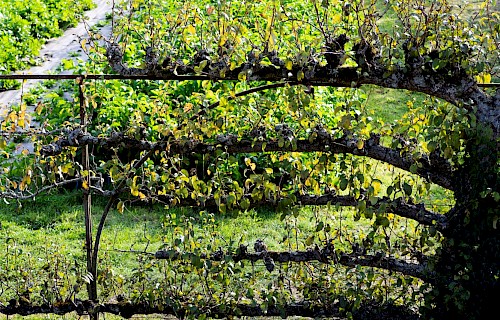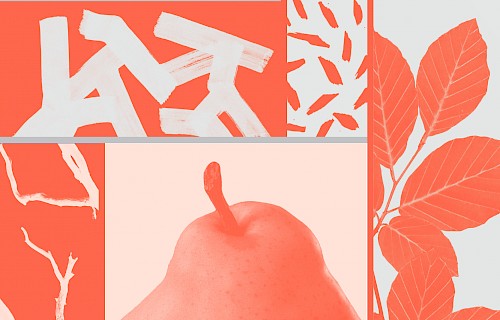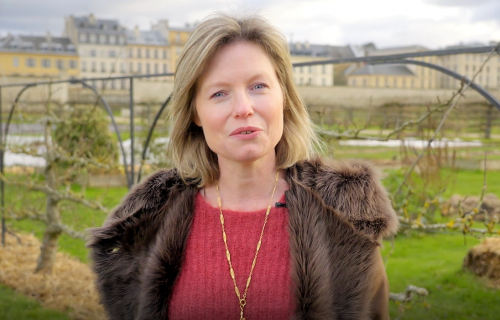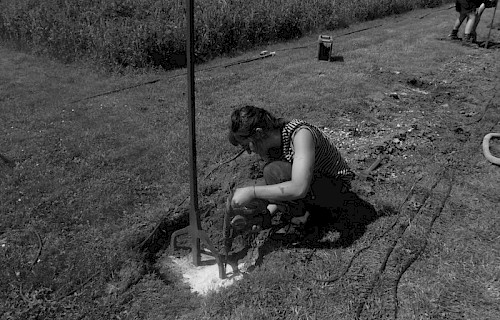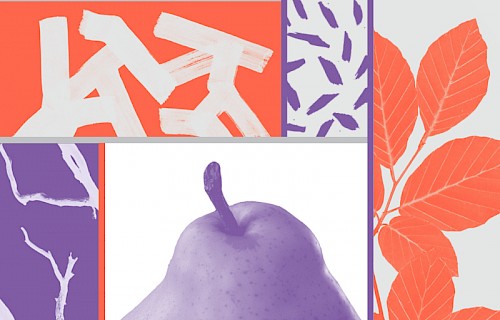discover Potager du Roi
Built between 1678 and 1683, at the request of Louis XIV and under the responsibility of architect Jules Hardouin-Mansart, Potager du Roi has remained true to its original mission: to produce, to experiment and to transmit.
Combining the useful with the pleasant
Chiara Santini, professor of Garden and Landscaping history
Originally with twenty-nine individual walled gardens planted with espaliered fruit trees, vegetables, aromatic herbs and small fruits surrounding a large central square divided into sixteen separate plots and a round fountain, crisscrossed by high walls, terrace walks and underground passages ... Potager du Roi is the representation of royal power over a domesticated and productive nature, that is thus considered pleasant. The walls and terraces create useful microclimates and frame scenes within the different areas of the garden. It is the unique atmosphere of this combination that continues to fascinate visitors.
Mirror of an ideal food system
Antoine Jacobsohn,
deputy director for École nationale supérieure de paysage, in charge of Potager du Roi
In his 1690 publication, Instruction pour les jardins fruitiers et potagers, Jean-Baptiste de La Quintinie proposes an engraving to introduce the epistle to the King. In the foreground of this engraving, there is a group of people. In its center, one of them presents a fruit basket to the only figure wearing a hat: it is La Quintinie who offers figs to Louis XIV. Here, the sovereign is not a person but the incarnation of France and the book thereby testifies to the desire to extend Potager du Roi beyond the court, to the whole of France. At the foot of the palace, the Potager is a microcosm and represents the entire nation. From hotbeds to the development of early or out of season produce, from attempts to naturalise exotic species to experiments with chemical sprays, from permaculture practices to landscape studies, the history of Potager du Roi is full of examples testifying to the evolution of food production methods and consumption habits over the past 350 years. Potager du Roi is a key witness and player as to the continuing evolution of our relationship to eating!
Restoration challenges
Jacques Moulin,
chief architect of Historical monuments
Faced with the evident degradation of Potager du Roi, exacerbated by the late December 1999 storm, Ecole nationale supérieure de paysage has launched the "work of the century" with the principal support of the Ministry of Agriculture and Food and additional help from the Ministry of Culture. Substantial rehabilitation is necessary. It is the third such occurrence in the history of the site. A large part of the architectural elements of the garden (walls, terraces, underground passages, espalier armatures of the Grand Carré, historical buildings, irrigation and drainage network, etc.) needs to be restored and the progressive replanting of the fruit trees needs to be conducted.
To nourrish and innovate
François-Xavier Delbouis,
chief gardener of Potager du Roi
Potager du Roi has always been an intensive production garden. In terms of agronomy, Jean-Baptiste de La Quintinie did not practice crop rotations. The depletion of the soil was compensated by massive additions of manure as well as topsoil. Today, for the team of 9 gardeners, with the cultivation of vegetables, perennial aromatic plants, a certain number of ornamentals plants and nearly 4,000 fruit trees (including 140 varieties of pears, 160 varieties of apples, as well as varieties of peach, fig, apricot, plum, etc.), the mission entrusted to La Quintinie, "nourish and innovate", is more relevant than ever. The evolution of cultivation procedures towards agroecological practices (agriculture on living soil, agroforestry) and the reactivation of market gardening practices dating from the beginning of the 19th century, aims to give Potager du Roi a head start in the direction of sustainable management and heritage conservation.
To share and transmit
Juliette Sibillat, head of the visitors and events department
Behind its high walls, Potager du Roi does not have a long tradition of being open. Starting as a specialized site, visited only by gardeners, students, teachers, professionals and a few privileged amateurs, the site was progressively opened to the general public in the 1990s. Working in collaboration with public and private educational institutions, in France and internationally, Ecole nationale supérieure de paysage is developing its public policy to promote site accessibility and allow everyone to make it their own.


